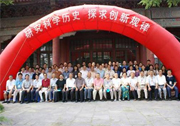| 英文摘要: |
Chinese internal alchemist Zhao Bichen (1860-1942) published his book Xingming Fajue Mingzhi (Clear Directions for Oral Teachings on the Inner Nature and Vital Force) in 1933. It incorporated western scientific concepts into traditional explications of internal alchemy, and became quite influential among alchemists. Much of the western medical knowledge in Zhao’s book can be traced back to Quanti Xinlun (A New Discourse on the Body), which was published in 1851 by British missionary Benjamin Hobson (1816-1873) and Chen Xiutang. There may be two reasons why an alchemist preferred Quanti Xinlun. First, missionaries already incorporated the western concept of the “soul” into the traditional Chinese concept of xinxing心性. It was convenient for an alchemist to pick up this incorporation. Second, Quanti Xinlun had long-lasting influence. This article reviews Zhao’s incorporation by explaining the difference between two concepts, the western “soul” and alchemical “yuanshen”. |





